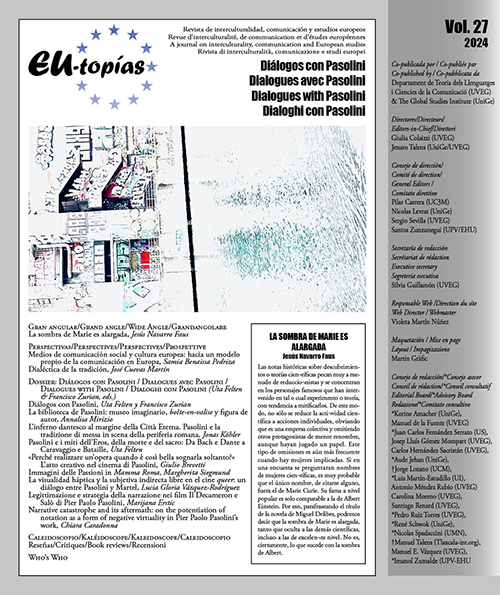Images of Passions in Mamma Roma
DOI:
https://doi.org/10.7203/eutopias.27.28696Keywords:
Mamma Roma, painting, Passion of the Christ, strategies of sacralisation, role of the mother. Abstract
Abstract
References to Christian mythology are frequent in Pasolini‘s films. Recourse to painting, but also to music, is used as a rewriting strategy and as a means of elevating figures from the subproletariat to the sacred, enabling the director to underline the messages he intended to convey through his work. Mamma Roma also makes several references to pictorial iconography and Christian mythology. The film immediately appears as a variation on a theme, that of the representation of the Passion of Christ. Numerous elements, not only iconographic, combine to represent Hector, the son of Mamma Roma as Christ. In this constellation, Mamma Roma is supposed to take on the role of Mary, a thesis confirmed by pictorial references. However, while the role of Mary in the Passion traditionally has a marginal position, the ending of the film Mamma Roma leads to the consideration of a different hypothesis. This paper examines the pictorial references in the film which support these thesis.
 Downloads
Downloads
 References
References
Alvaro, Corrado: Il nostro tempo e la speranza. Saggi di vita contemporanea, Milano: Bompiani, 1960.
Bona Castellotti, Marco: Piero secondo Pier Paolo, in
https://www.ilfoglio.it/gli-inserti-del-foglio/2016/05/02/news/piero-secondo-pier-paolo-95614/.
Bonitzer Pascal: Mamma roma - 1976 - cahiers du cinema 265, p. 66.
Dechert, Antje: Stars all»italiana: Kino und Körperdiskurse in Italien (1930–1965), Köln: Böhlau, 2014.
Grignaffini, Giovanna: La scena madre. Scritti sul cinema, Bologna: Bononia University Press, 2002.
Groß, Bernahrd: Pier Paolo Pasolini. Figurationen des Sprechens, Berlin: Vorwerk, 2008.
Luzzi, Giovanni(ed.): La sacra Bibbia, Roma: Libreria Sacre Scritture,1984.
Magrelli, Enrico; Pasolini, Pier Paolo: Con Pier Paolo Pasolini, Roma: Bulzoni, 1977.
Marchesini Alberto: Citazioni pittoriche nel cinema di Pasolini: da Accattone al Decameron, Firenze: La nuova Italia, 1994.
Mörchen, Kristine: Le donne che si pagano. Prostitution im italienischen Film von 1950 bis heute, Göttingen: V&R unipress, 2011.
Murgia, Michela: Ave Mary. E la chiesa inventò la donna, Torino: Einaudi, 2011.
Pasolini Pier Paolo: La ricerca di una casa, in: [idem]: Tutte le poesie, Milano: Mondadori 2003, vol. I, p. 1105.
Pasolini, Pier Paolo: recensione(18 gennaio 1974) al volume di R. Longhi, Da Cimabue a Morandi, a cura di G. Contini, Milano, 1973, ora in Saggi sulla letteratura e sull’arte, Milano, 1999, vol. II, p. 1977.
Pasolini, Pier Paolo; Magrelli, Enrico : Con Pier Paolo Pasolini, Roma: Bulzoni, 1977.
Pasolini, Pier Paolo: Le belle bandiere. Dialoghi 1960-65, a cura di Ferretti, Giancarlo, Roma: Editori Riuniti, 1970.
Pasolini, Pier Paolo: Supplica a mia madre, in Poesia in forma di rosa (1961-1964), Milano: Garzanti 1964.
Pasolini, Pier Paolo: La ricotta, episodio del film RoGoPag, 1963.
Pasolini Pier Paolo: Sfogo per «Mamma Roma», in Vie nuove, n. 40, 4 ottobre 1962, ora in Id.: I dialoghi, a cura di Giovanni Falaschi, Roma: Editori Riuniti, 1992.
Pasolini, Pier Paolo: Mamma Roma, 1962.
Rey Mimoso Ruiz, B: Manèges et espaces de marginaux de Jorge Amado (Papites da areia, 1937) et Luis Bunuel (Los Olvidados,1950) à Pier Paolo Pasolini (Mamma Roma ,1962) et Vicente Aranda (Tiempo de silecio,1986) in: Les langues néo-latines, 309, p. 133-144.
Rhodes, John David: Stupendous, Miserable City. Pasolini’s Rome, Minneapolis: University of Minnesota Press, 2007.
Ryan-Scheutz, Colleen: Sex, the self and the sacred, Toronto: University of Toronto Press, 2007.
Sartoni, Eleonora: (Mamma) Roma between Archaic and Modern Italy: Urbanisation and the Destruction of Poetical Dwelling in http://sensesofcinema.com/2015/pier-paolo-pasolini/mamma-roma/
Downloads
Published
How to Cite
-
Abstract73
-
PDF 31
Issue
Section
License
![]()
The authors conserve the copyright. All content published in EU-topías. Journal of interculturality, Communication, and European Studies are subject to the license Creative Commons Attribution-NonCommercial-ShareAlike 4.0 license. The full text of the license can be found at <http://creativecommons.org/licenses/by-nc-sa/4.0>
They may be copied, used, disseminated, transmitted and publicly displayed, provided that:
- The authorship and original source of the publication is cited (journal, publisher and URL of the work).
- They are not used for commercial purposes.
- The existence and specifications of this license of use are mentioned.
It is the responsibility of the authors to obtain the necessary permissions for images that are subject to copyright.



